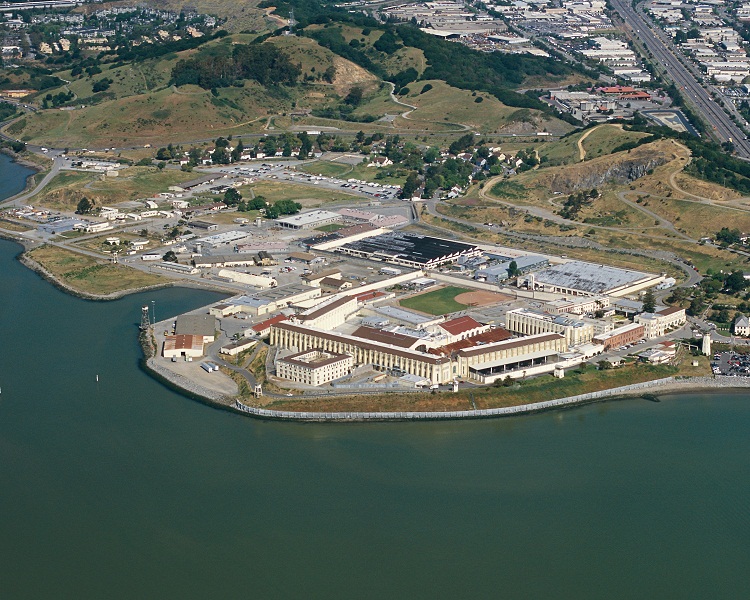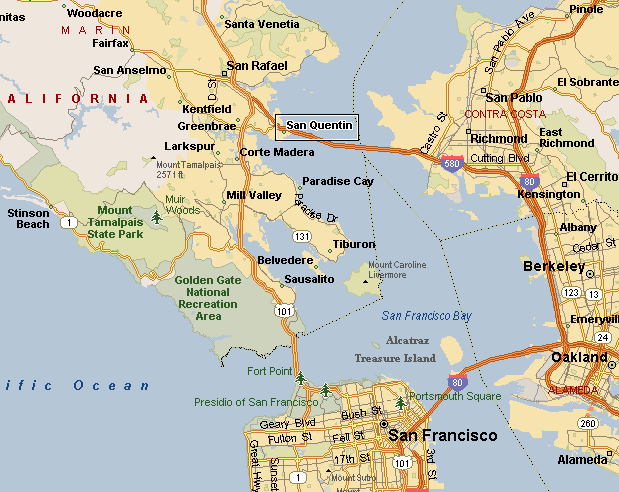<Back to Index>
- San Quentin, California San Quentin State Prison, 1852
PAGE SPONSOR


San Quentin State Prison is a California Department of Corrections and Rehabilitation state prison for men in unincorporated San Quentin, Marin County, California, United States. Opened in July 1852, it is the oldest prison in the state. California's only death row for male inmates, the largest in the United States, is located at the prison. It has a gas chamber, but since 1996, executions at the prison have been carried out by lethal injection. The prison has been featured on film, video, and television; is the subject of many books; has hosted concerts; and has housed many notorious inmates.
The correctional complex sits on Point San Quentin, which comprises 432 acres (175 ha) of desirable waterfront real estate overlooking the north side of San Francisco Bay. The prison complex itself occupies 275 acres (111 ha), valued in a 2001 study at between $ 129 million and $ 664 million.
The prison complex has its own ZIP code for mail sent to inmates, 94974; the ZIP code of the adjacent community of Point San Quentin Village is 94964. It is bordered by San Francisco Bay to the south and west and by Interstate 580 to the north and east, near the northern terminus of the Richmond - San Rafael Bridge.
As of December 2008, the prison had a design capacity of 3,082 but a total institution population of 5,256, for an occupancy rate of 170.5 percent. It has Level I ("Open dormitories without a secure perimeter") housing; Level II ("Open dormitories with secure perimeter fences and armed coverage") housing; a Reception Center (RC) which "provides short term housing to process, classify and evaluate incoming inmates"; and a Condemned unit.
As
of Fiscal Year 2006 / 2007, the prison had 1,718 staff and an annual
budget of $ 210 million. It is one of the largest prisons in the United
States with a population of 5,222 inmates as of December 2008. Men condemned to death (with some exceptions) must be held at San Quentin, while condemned women are held at Central California Women's Facility in Chowchilla, California. As of December 2008, San Quentin held 637 male inmates in its Condemned unit, or "death row." As of 2001, San Quentin's death row was described as "the largest in the Western Hemisphere"; as of 2005, it was called "the most populous execution antechamber in the United States." The states of Florida and Texas had fewer death row inmates in 2008 (397 and 373 respectively) than San Quentin. The
death row at San Quentin is divided into three sections: the quiet
"North - Segregation" or "North - Seg," built in 1934, for prisoners who
"don't cause trouble"; the "East Block," a "crumbling, leaky maze of a
place built in 1927"; and the "Adjustment Center" for the "worst of the
worst." Although
$395 million was allocated in the 2008 - 2009 state budget for new death
row facilities at San Quentin, in December 2008 two legislators introduced bills to eliminate the funding. As noted above, all executions for men in California must occur at San Quentin. The
methods for execution at San Quentin have changed over time. Between
1893 and 1937, 215 people were executed at San Quentin by hanging, after which 196 prisoners died in the gas chamber. In
1995, the use of gas for execution was ruled "cruel and unusual
punishment," which led to executions inside the gas chamber by lethal
injection. Between 1996 and 2006, 11 people were executed at San Quentin by lethal injection. In April 2007, staff of the California Legislative Analyst's Office discovered
that a new execution chamber was being built at San Quentin;
legislators subsequently "accuse[d] the governor of hiding the project
from the Legislature and the public." The old lethal injection facility had included an injection room of 43 square feet (4.0 m2) and a single viewing area; the facility that was being built included an injection chamber of 230 square feet (21 m2) and three viewing areas for family, victim, and press. Governor Arnold Schwarzenegger stopped construction of the facility the next week. The Legislature later approved $ 180,000 to finish the project, and the facility was completed. In addition to State executions, three Federal executions have been carried out at San Quentin. Samuel Richard Shockley and Miran Edgar Thompson had been incarcerated at Alcatraz Island federal penitentiary and were executed on December 3, 1948 for the murder of two prison guards during the Battle of Alcatraz. Carlos
Romero Ochoa had murdered a federal immigration officer after he was
caught smuggling Mexican aliens across the border near El Centro, California. He was executed at San Quentin's gas chamber on December 10, 1948. Although numerous towns and localities in the area are named for Roman Catholic saints, and "San Quintín" is Spanish for "Saint Quentin", the prison is not named after the saint. The land on which it is situated, Point Quentin, is named after a Coast Miwok warrior named Quentín, fighting under Chief Marin, who was taken prisoner at that place. In
1851, California's first prison opened; it was a 268 ton wooden ship
named The Waban, anchored in San Francisco Bay and outfitted to hold 30 inmates. After a series of speculative land transactions and a legislative scandal, inmates who were housed on the Waban constructed San Quentin which "opened in 1852 with 68 inmates." A dungeon built at San Quentin in 1854 is thought to be California's oldest surviving public work. The prison held both male and female inmates until 1932 when the original California Institution for Women prison at Tehachapi was built. In 1941 the first prison meeting of Alcoholics Anonymous took place at San Quentin; in commemoration of this, the 25 millionth copy of the AA Big Book was presented to Jill Brown, of San Quentin, at the International Convention of Alcoholics Anonymous in Toronto, Ontario, Canada. The use of torture as an approved method of interrogation at San Quentin was banned in 1944. Alfredo Santos,
one - time convicted heroin dealer and successful artist, painted six
remarkable, 20 ft (6.1 m) sepia toned murals during his
1953 - 1955 incarceration that have hung in the dining hall of the prison. Lawrence Singleton,
who raped a teenaged girl and cut off her forearms, spent a year on
parole in a trailer on the grounds of San Quentin between 1987 and 1988
because towns in California would not accept him as a parolee. Between 1992 and 1997, a "boot camp"
was held at the prison that was intended to "rehabilitat[e] first - time,
nonviolent offenders"; the program was discontinued because it did not
reduce recidivism or save money. A
2005 court ordered report found that the prison was "old, antiquated,
dirty, poorly staffed, poorly maintained with inadequate medical space
and equipment and overcrowded." Later
that year, the warden was fired for "threaten[ing] disciplinary action
against a doctor who spoke with attorneys about problems with health
care delivery at the prison." By 2007, a new trauma center had opened at the prison and a new $ 175 million medical complex was planned.